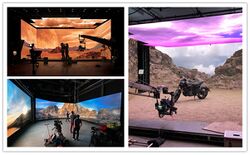Engineering:Immersive LED screen
Definitions
The LED immersive display stands at the forefront of cutting-edge technology, serving as a pivotal component in crafting immersive experiences, whether within the realm of virtual reality or as standalone captivating installations. Its significance lies in its ability to transport audiences into realms unattainable in the physical world, leveraging captivating visuals and realistic rendering techniques to offer truly remarkable and entertaining encounters.
At its core, the immersive LED display serves as a gateway to boundless creativity, enabling creators to fashion entire universes that defy the constraints of reality. Through its mesmerizing visuals, viewers are seamlessly drawn into richly detailed environments, where every scene pulsates with life and energy, fostering a sense of wonder and excitement unparalleled by conventional media formats.
A diverse array of immersive LED configurations exists to cater to varying needs and preferences. These include the three-sided LED screen, which envelops viewers in a panoramic spectacle, creating a sense of depth and dimensionality that extends beyond traditional display boundaries. Similarly, the four-sided LED screen surrounds audiences with visuals on all sides, plunging them into a fully immersive sensory experience.
For those seeking the ultimate immersive escapade, studios equipped with ceiling-mounted LED displays coupled with floor-level LED panels offer an unparalleled level of immersion, enveloping participants in a 360-degree canvas of sights and sounds. Meanwhile, the five-sided LED display pushes the boundaries even further, introducing overhead visuals to complement the surrounding screens, resulting in a truly all-encompassing sensory adventure.
In essence, the immersive LED display represents a revolutionary leap forward in the realm of visual storytelling, ushering in a new era of experiential entertainment where boundaries dissolve, and imagination reigns supreme. Whether as a tool for virtual reality experiences, dynamic advertising, or awe-inspiring art installations, its potential knows no bounds, promising to captivate and inspire audiences for generations to come.
Features
1. Customization and Scalability: Immersive LED screens offer a high degree of customization and scalability, allowing creators to tailor the display size, shape, and resolution to suit specific requirements. This flexibility enables the creation of immersive environments in various spaces, from small-scale installations to large-scale venues.
2. Interactive Capabilities: Some immersive LED screens feature interactive elements, enabling real-time engagement with the content. This interactivity can enhance the user experience by allowing viewers to actively participate in the narrative or manipulate the visuals through gestures or other inputs.
3. Content Creation and Management: Immersive LED screens often come with dedicated content creation and management tools that streamline the process of designing, scheduling, and updating content. These tools may include intuitive software interfaces and cloud-based platforms for seamless content distribution across multiple screens.
4. Integration with Other Technologies: Immersive LED screens can integrate with other technologies such as augmented reality (AR) and spatial audio systems to create even more immersive experiences. By combining these technologies, creators can deliver multisensory experiences that blur the lines between the physical and digital worlds.
5. Versatile Applications: Immersive LED screens find applications across various industries and sectors, including entertainment, education, retail, hospitality, and corporate events. They can be used for virtual tours, interactive exhibitions, product showcases, live performances, training simulations, and much more.
6. Health and Safety Considerations: When deploying immersive LED screens, it's essential to consider health and safety factors such as eye comfort, motion sickness prevention (especially in virtual reality applications), and adherence to safety regulations for installation and operation.
7. Future Trends: As technology continues to advance, immersive LED screens are expected to become even more sophisticated and accessible. This may include advancements in display resolution, refresh rates, color accuracy, and energy efficiency, as well as the integration of emerging technologies such as holography and volumetric displays.

